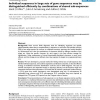365 search results - page 18 / 73 » bmcbi 2005 |
BMCBI
2005
13 years 11 months ago
2005
Background: Detection of sequence homologues represents a challenging task that is important for the discovery of protein families and the reliable application of automatic annota...
BMCBI
2005
13 years 11 months ago
2005
Background: Computational methods for problem solving need to interleave information access and algorithm execution in a problem-specific workflow. The structures of these workflo...
BMCBI
2005
13 years 11 months ago
2005
Background: Most current DNA diagnostic tests for identifying organisms use specific oligonucleotide probes that are complementary in sequence to, and hence only hybridise with th...
BMCBI
2005
13 years 11 months ago
2005
Background: A common feature of microarray experiments is the occurence of missing gene expression data. These missing values occur for a variety of reasons, in particular, becaus...
BMCBI
2006
13 years 11 months ago
2006
Metabolic networks are naturally represented as directed hypergraphs in such a way that metabolites are nodes and enzyme-catalyzed reactions form (hyper)edges. The familiar operat...

